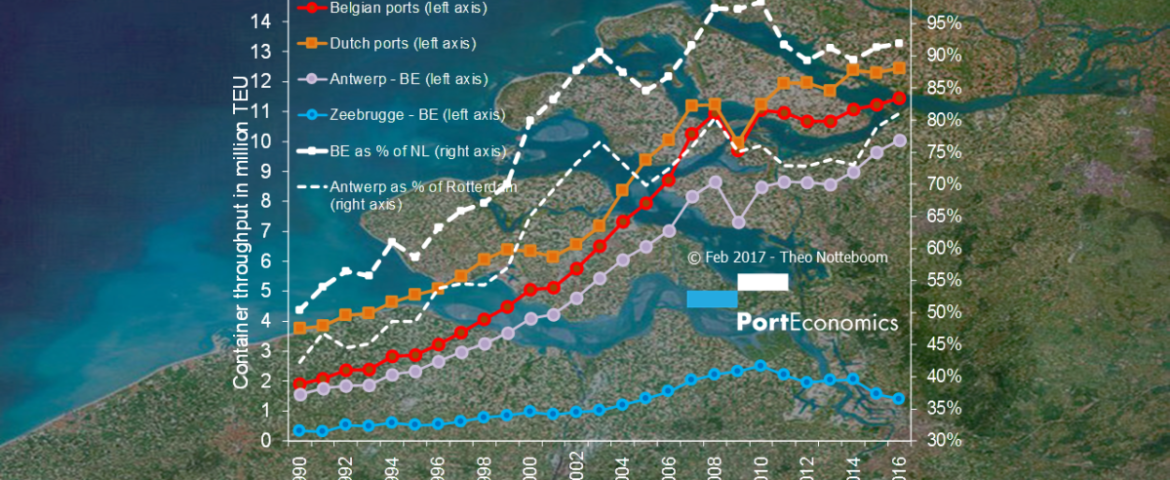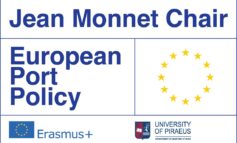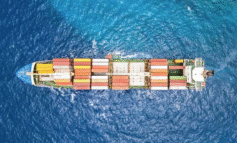Belgian and Dutch container ports are part of the Rhine-Scheldt Delta, the largest container port region in Europe in volume terms. Dutch and Belgian ports together handled 23.9 million TEU in 2016 or 1.55% more than in 2015.
Rotterdam continues to dominate the Dutch container port system handling 12.38 million TEU in 2016, a small increase of 1.2% compared to 2015. Rotterdam represents 99.5% of all container volumes handled in Dutch ports. Its lowest share ever was recorded in 2006 (i.e. 96%) when the port of Amsterdam temporarily played a modest role in the deepsea container market.
The Belgian container port system relies on two ports: upstream port Antwerp and coastal port Zeebrugge, with bulk and break bulk port Ghent (now in the process of merging with Dutch neighbour Zeeland Seaports) handling a very small container volume. Antwerp had a strong growth of 7.5% in container throughput in 2015 and continued on this path in 2016 with a healthy 4% growth. The Scheldt port, Europe’s second largest container port, reached just over 10 million TEU in 2016, thereby broadening the throughput gap with Hamburg, Europe’s third largest container port. The Belgian port of Zeebrugge initially overcame the crisis very well, even becoming the ninth largest container port in Europe in 2010, but afterwards booked traffic losses. This trend further reinforced in 2015 and 2016 with a significant drop in container volumes of 23.8% in 2015 and a further drop of some 10% in 2016. While Antwerp reaped the full benefits of the reshuffling in strategic alliances in liner shipping including an increase in Far East service calls, the same developments continue to negatively affect Zeebrugge’s position. Thanks to Antwerp’s strong performance, the Belgian port system saw a modest traffic increase from 11.23 million TEU in 2015 to 11.45 million TEU in 2016 (+1.9%).
Combined container volumes in the Belgian container ports closed in fast on Dutch ports during the 1990s and the early 2000s. In 2010 the gap was almost closed, but in more recent years the traffic difference stabilized at around 10%. The graph shows that 2016 did not significantly change the throughput balance between Belgian and Dutch ports: in 2016 the Belgian container port system handled 8.1% less than the Dutch port system. In 2015 the throughput gap was 8.7%. The throughput gap between Antwerp and Rotterdam has narrowed down to 19%, a figure comparable to the year 2008. The recent announcements by 2M, THE Alliance and Ocean Alliance demonstrate that competition between Rotterdam and Antwerp on the Europe-Far East trade is in full swing. Antwerp hopes to feel the full impact of last year’s move of the MPET terminal from the Delwaidedock on the right bank of the Scheldt River to the Deurganckdock on the left bank, giving MSC and its 2M partner Maersk Line much needed room for further growth. Antwerp also hopes to further advance its plans for the construction of a new Saeftinghedock. The port of Rotterdam is hoping that its two large scale new container facilities at Maasvlakte 2 will have their full impact in 2017. Zeebrugge is gasping for breath in the deepsea container business while consolidating its position as the no. 1 car handling port in the world and a key roro port for the UK market. It remains to be seen whether the commercial (container) alliance between Antwerp and Zeebrugge announced back in late 2015 will lead to tangible actions in 2017.













